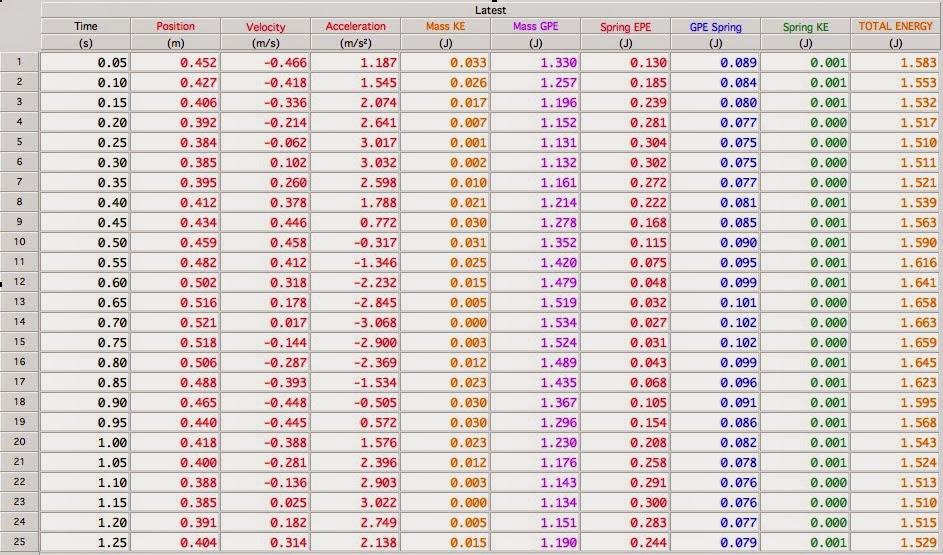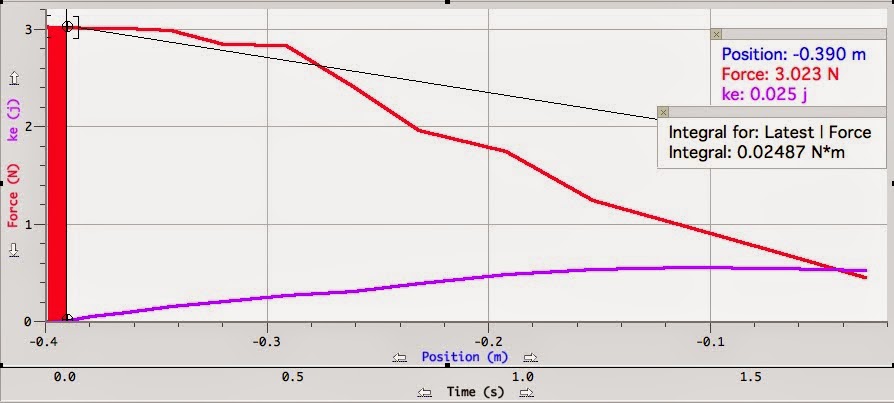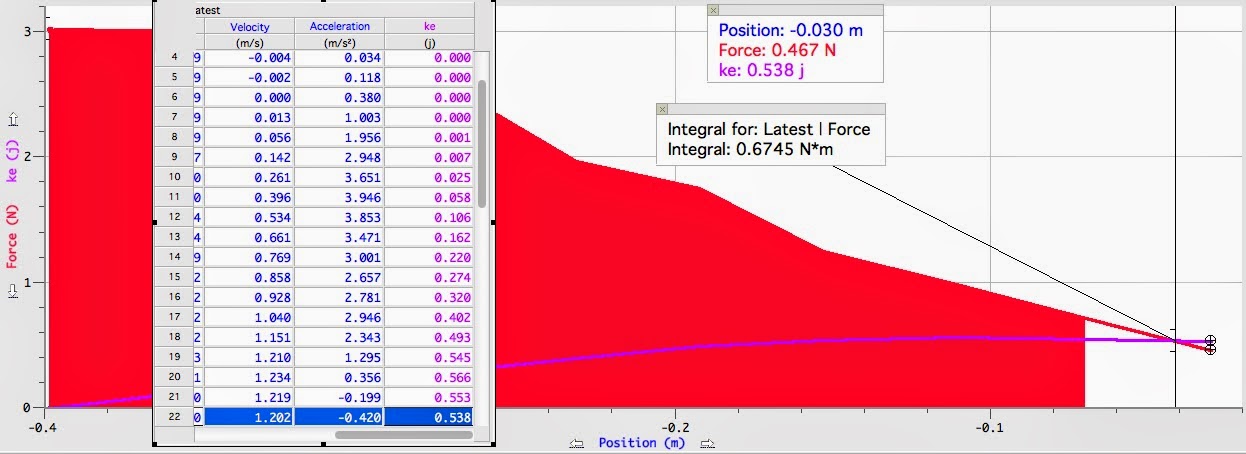Purpose
Procedure + Lab Setup
Wednesday, October 22, 2014
Lab 12: Collisions 10/15
Purpose
Procedure + Lab Equipment
Data
Calculations + Data Analysis
Conclusions
Procedure + Lab Equipment
Data
Calculations + Data Analysis
Conclusions
Thursday, October 16, 2014
Lab 11: Impulse-Momentum Theorem 10/13
Purpose
In this lab, we wanted to test if the impulse-momentum theorem is true - that impulse is equal to the momentum.
Procedure + Lab Equipment
What we used:- track
- cart
- clay + nail
- the clay was placed on a wooden block and the nail on the force sensor - this was for the inelastic collision
- logger pro
- force sensor + motion sensor
Part 1 - Elastic Collision (bouncing)
- on one end of the track, a spring was placed at the end
- at the other was the motion sensor
- the force sensor was attached to one end of the cart
- the cart with the force sensor is then weighed
- the force sensor was calibrated and then placed on the cart
- data was collected as the cart is pushed into the spring
- this is repeated with an additional mass on the cart
- the same as part one, except the spring is changed with clay
- a nail is attached to the end of the force sensor
Data
Part 1 -Elastic Collision |
| This is the data for the cart |
 |
| This is the data for the cart with an additional mass |
 |
| This is the data for when the cart collides with the clay |
Calculations + Data Analysis
Using the equations of momentum, we were able to calculate the momentum of the cart and compare it to the impulse of the cart.
Conclusion
We found that the theorem is true....
Tuesday, October 14, 2014
Lab 10: Magnetic Potential Energy 10/8 - 10/13
Purpose
In this lab, we are using the relationship between force and distance to find the potential energy of the magnet and see that the conservation of energy applies to this system as well.
Procedure + Lab Equipment
What we used:- air track + vacuum
- glider cart
- angle reader
- motion sensor
- We placed the air track at an angle (day 1)
- we let the glider go measured how far away the glider was from the magnet
- we repeated this step at different angles for a total of 5x
- We leveled the track and then gave the glider a push toward the magnet (day 2)
Data
%2B10.13.tiff) |
| The graph is the relationship between the force and the distance |
 | |
| This is the data for the cart when the track is leveled |
Calculations + Data Analysis
 |
| This is the data for energy at each point |
 |
| This is the graph that shows the PE and KE as the glider approaches and then moves away from the magnet. |
Summary
Monday, October 6, 2014
Lab 9: Conservation of Energy in a Mass-Spring System 10/6
Purpose
In this lab, we measured the kinetic energy (KE) and gravitational potential energy (GPE) for the mass and spring, and elastic potential energy (EPE) for the spring to verify that energy is conserved through out the system.
Procedure + Lab Equipment
What we used:
- ring stand + clamp
- spring
- mass
- ruler
- logger pro
- motion sensor + force sensor
 |
| This is the lab set up for when the spring is stretched, below is the motion senor |
What we did:
- we used the motion sensor to record the height of the spring when it was not stretched and when it was stretched
- we attached the top end of the spring to the force sensor and hung the mass at the other end of the spring
- we weighed the spring
- we then took the final reading as the mass was hung on the spring
Data
 |
| With logger pro, we were able to record the velocity of the spring as it moved |
 |
| The slope is the k constant of the spring
show integration work
|
Calculations + Data Analysis
 | |
| The data table that calculates KE, GPE, EPE, and Total Energy at each point as the spring oscillated from stretched to not stretched |
This is the data table we created to find KE, GPE, and EPE of the mass and spring at each point as the spring oscillated between stretched and not stretched. We then took those numbers and created a column for the total energy at each point. From the data table we see that the total energy through out the system appears to be consistent.
From this graph we can see that when the spring is stretched, the total energy stays consistent, unlike when it bounces back up.
 |
| From this graph, we can actually see a clearer picture-that energy is consistent at every point as the spring goes from not stretched to stretched. |
Summary
In this lab, we wanted to verify that in a mass-spring system, that the conservation of energy was true. We used logger pro to measure the velocity and position over a period of 10 seconds to help us find the energies at each point. Our graph showed that the energy was consistent throughout those 10 seconds, so, we were able to verify the conservation of energy in a mass-spring system.
Friday, October 3, 2014
Lab 8: Work-KE Theorem 10/1 - 10/6
Purpose
In this lab, we wanted test our hypothesis that, based on the work-kinetic energy theorem, the work done on the spring is equal to the kinetic energy of the spring.
Procedure + Lab Equipment
What we used:- cart + block
- ramp
- spring
- logger pro
- force sensor + motion sensor
- the mass of the cart + block was measured
- attached one end of the spring to the cart
- calibrated the force sensor
- we then connected the force sensor to the other end of the spring and let the spring at rest and zeroed
- stretched the spring and let go - recorded the data
Data
 |
| Graph 1 |
 |
| Graph 2 |
 |
| Graph 3 |
 |
| Graph 4 |
Calculations + Data Analysis
Kinetic energy is found through...
 |
| This is how the kinetic energy is found. |
 |
| These are the percent errors for their respective graphs |
We can see that throughout the graph, work is close to equal to the kinetic energy. So, we found that the work-kinetic theorem to be true.
Summary
In this lab, we set out to test if the work-kinetic energy theorem is true. We used a cart-spring system to see if the work done was equal to the kinetic energy. Our data shows that work was close to equal to the kinetic energy. We aren't going to get exact numbers due to some errors. Our spring was resting on something, as can be seen in the lab set up. This may have affected our data.
Though are numbers weren't exact, they did let us see that the work-kinetic energy theorem works.
Thursday, October 2, 2014
Exam 1: Labs/Activities
-
1)
Period of an inertia balance
-
2)
Sparker/FreeFall lab/Standard deviation of a data set
-
3)
Modeling non-constant acceleration on Excel (rocket-powered elephant activity)
-
4)
Modeling air resistance (coffee filters lab)
-
5)
Projectile motion activity/lab (launch ball, findv0, predictwhere it would hit an angled ramp)
-
6)
Determining density of cylinders/mass of suspendedobject (propagated uncertainty)
-
7)
Coefficients of friction stuff- a)
static friction with cup and water
-
b)
kinetic friction with force sensor
-
c)
static friction from angle to get sliding
-
d)
kinetic friction from sliding block on a steep ramp - e)
predicting acceleration of a two-mass system—oneon a friction ramp, the other hanging
- a)
-
8)
centripetal acceleration as a function of angular speed(spinning horizontal wheel with an accelerometer on it)
-
9)
relationship between angular speed (ω) and angle ofthe string above the vertical (θ) for a particular rotating apparatus
Subscribe to:
Comments (Atom)



